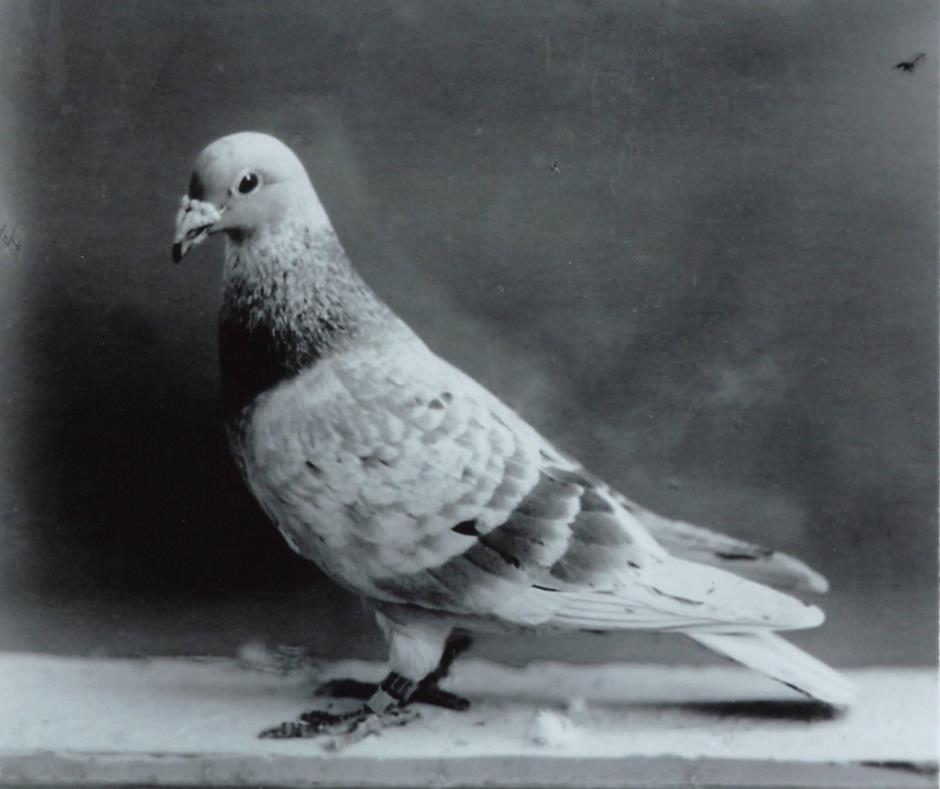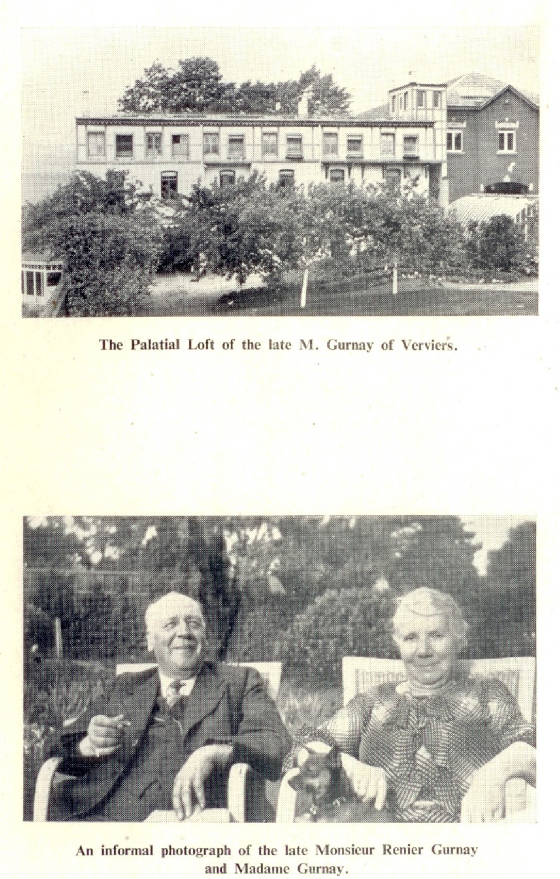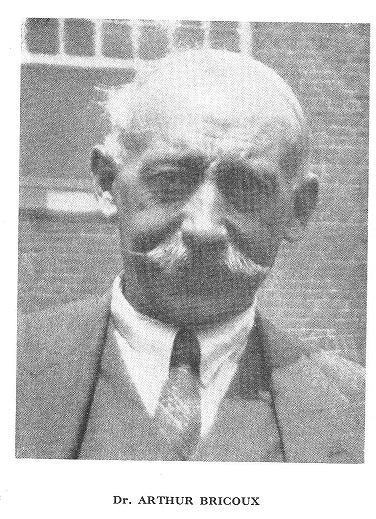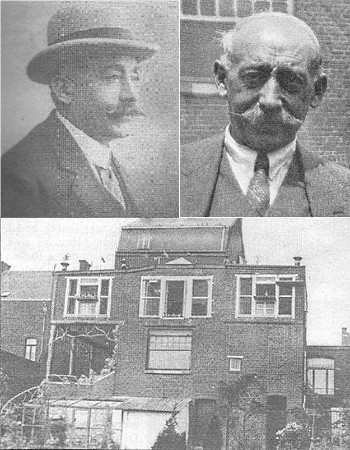Dr. Arthur Bricoux
Dr. Arthur Bricoux, Master Breeder, 1874 -1944, Jolimont, Belgium,.
- Steve O'Dea
- March 23, 2021
- 2:37 pm
Watch, Listen or Read about Dr. Bricoux below here....
Who was the best pigeon fancier of all time – a question often asked. The most consistent answer for many would be “Dr Bricoux”. Without doubt, he was the greatest master in the period between 1919 and 1939. Between the 2 wars, he won an incredible number of prizes in the National and long-distance events. In ten years, during the period from 1930 through 1939, he won 14 First Prizes, 12 Seconds, and 124 prizes within the first 20 places of top level races. His successes were so numerous and so outstanding that there had even been allegations that he must have been doping his pigeons.
Arthur Bricoux was interested in pigeons during his university studies, while attending medical school, and fifty years later, it was clear that his passion for the sport had not dimninished. To defend the position of being consider the top fancier and racer over a period of 25 years is nothing short of astounding !
 “His successes were so numerous and so outstanding that there had even been allegations that he must have been doping his pigeons.”
“His successes were so numerous and so outstanding that there had even been allegations that he must have been doping his pigeons.”
He was a student of genetics and performances, with an innate ability to get the combinations perfect – resulting in winner after winner, breeder after breeder. His first pigeons were the Beeckmans and the Celliers’s (Lorette’s). These were added to pigeons he later found, called the Baclenes from Walcourt and the Rousseaus from Jemeppe. He also exchanged some young birds with the great French Champion, Paul Sion of Tourcoing, and the crossings which resulted gave him fantastic results. Although an inbreeder of pigeons, Dr. Bricoux confessed that sometimes he used an out-cross as too much successive inbreeding leads to a decline in the performances. The Doctor maintained that those who did not seek an outcross at some point would watch their colony decay. Ideally, an outcross to another inbred family was his preferred solution to this problem, and the progeny should be hard tested thereafter before completely integrating the 2 families further.
Arthur Bricoux became an established name and that served him well, because none other than the brothers Baclène van Walcourt were interested in exchanging pigeons with the doctor. That’s how it was then and that’s how it goes now: champions are looking for champions to breed together and or to exchange pigeons, and usually with a sharing of the progeny. Baclène chose two hens in Jolimont and the doctor selected two red cocks in Walcourt. One of them, a Red one, was a grandson of the famous Brun of Baclène. The other, also a Red one, was a grandson of their “Vieux Pâle” a pure Wegge who was 1st national Saint-Vincent.
Bricoux was not really fond of large pigeons. That was actually one of his biggest problems, that neither the Carliers nor the Beeckmans – who were nevertheless better muscled – match his “standard”. But Bricoux had enough faith in his own breeding art to dissolve these traits. A first attempt to do so – he himself says in the foreword to his sale in 19630 – was the purchase of a small Grey cock at the public sale of the Rousseau Brotehrs. He called him “Le Petit Mouhy”. The idea of making its baselines rounder and more compact, failed miserably. After a few generations, the model of the Petit Mouhy was almost completely overgrown by the Antwerp type of the Grooters (read Beeckman) and Lorettes (read Carlier).
 “That’s how it was then and that’s how it goes now: Champions are looking for Champions to breed together and/or to exchange pigeons………….”
“That’s how it was then and that’s how it goes now: Champions are looking for Champions to breed together and/or to exchange pigeons………….”
Only the gray colour remained in the trunk. That Grey will also leave traces in numerous long distance pigeons and it was via a gray Bricoux that introduced the colour to the Delbar strain. As already mentioned, Bricoux succeeded in positively influencing the type of his pigeons with the Wegge-doffer from Omnozez. He would then do the same and with great success with Baclène’s Wegges. He paired a daughter of the Rouge Beeckman with a red Baclène, namely the grandson of the Vieux Pâle. Bricoux was delighted with his experiment. In his own words, he bred the most beautiful pearls of pigeons that you can dream of from this couple: good, perfect athletes and beautiful. Their names are on record for eternity: La Bonne à l’Oeil Blanc, Le Janot, Le Cravaté, La Petite Rousse. The latter not only won5th Nat. Dax, but she also bred a plethora of champions, including Jules César.
 “Bricoux only brought in inbred pigeons. Why? For the sake of stability in his family:……….”
“Bricoux only brought in inbred pigeons. Why? For the sake of stability in his family:……….”
If the imported pigeon “caught” with his own family, he could then replicate or repeat that breeding with more consistent results. An important contribution of new blood came in Jolimont from an exchange with the French champion Paul Sion from Tourcoing. Sion was primarily a buyer of pigeons, and only bought from the best. From what Bricoux obtained at Sion, only the Ecaillé Sion, a son of the Etalon of Sion, was found to be worthy of breeding. The Etalon was a pure Wegge of origin. Bricoux paired him with la Belle Rousse, a full sister of Jules César, daughter of the only real stock couple that Bricoux ever owned. From the Ecaillé Zion with the Mooi Rosse came the best pigeons, such as the Brun, the Rouge Libourne (sometimes called l’Oeil Gris (gray eye)) and The Libourne, which was a world class hit pigeon.
 “An important contribution of new blood came in Jolimont from an exchange with the French champion Paul Sion from Tourcoing.”
“An important contribution of new blood came in Jolimont from an exchange with the French champion Paul Sion from Tourcoing.”
Bricoux never raced Youngbirds, and only began racing the birds as yearlings – usually on the natural method before putting them on the widowhood system as 2 year olds. Dr. Bricoux was one of the very early adopters of the widowhood method of racing pigeons, and this probably propelled him forward in his performances over many of the other fanciers who were still racing natural at the time. These 2 year old birds would be sent to races at 600km, whilst the older, more experienced birds would be sent to the longest international races, at 1000km or more. His own preference was for the longest of the races, preferring to use the shorter races to bring his birds into form and condition.

Dr. Bricoux had a preference for birds with very strong vent bones, carried on a well-built and muscular frame with soft feathering all over. With regards to feathering and wings, he preferred birds with long secondary feathers on the inside wing, proclaiming that birds with short inside-wing feathers were neither suitable for long or even medium length races. The over-riding thought was that the beauty or absence of it in a bird told nothing about its athletic abilities, and that the basket was the best judge of all !
Doctor Bricoux sold quite a few pigeons. In 1930 he even sold a whole series of his champions together with a lot of youngsters. It is whispered that he urgently needed money to pay off the debt of one of his children. But given his all-surpassing results, and as one can imagine – his pigeons were very sought after by the long-distance fans: men like Van der Espt and Hector Desmet were regular customers. But Bricoux also had his regular purchasers and “out-lofts”, first and foremost Senator Ernest Duray of Ecaussines, who beat the doctor more than once with his own pigeons in the national races. Caramin (Châtelet) also almost only had Bricoux pigeons; at Nestor Tremmery (Oudenburg) there was certainly half of the Bricoux colony and we certainly do not forget champions such as Demarets, Demil, Gebr. Danhaive, Oscar Blaimont
 “His pigeons were very sought after by the long-distance fans: men like Van der Espt and Hector Desmet were regular customers…………”
“His pigeons were very sought after by the long-distance fans: men like Van der Espt and Hector Desmet were regular customers…………”
in 1940 the Germans marched into Belgium while the Allies systematically lost ground. Doctor Bricoux fled with his family across the border and left his pigeon colony to a caretaker. Because the reputation of the Bricoux pigeons was known all over Western Europe and carrier pigeons were considered a powerful weapon in wartime, the French army did not in any way want the pigeons of Dr. Bricoux to fall into hostile hands. Instead of bringing the pigeons to safety, they were mercilessly killed on the spot by French soldiers. Undoubtedly the most insane act in the history of pigeon sport … The life’s work of the doctor was quickly destroyed. Dr. Bricoux never got over it. Luckily for Dr. Bricoux, 2 great friends of his agreed to assist him in recreating his colony of pigeons, they were Nestor Tremmery of Oudenburg, and Arthur Caramin of Chatelet. The best stock pigeons of Caramin and Tremmery were blended in with the experience of Bricoux, and an entire round of youngsters were brought over from Oudenburg and Chatelet to Jolimont. The entire pigeon fancy at that time, was assured that this was to be the start of a new, all conquering colony. Alas, it was to be for only a short period of time, for with the colony barely re-built – Dr. Bricoux died, in the prime of his life, but with the firm hope that his life’s work would be continued.

 “Alas, it was to be for only a short period of time, for with the colony barely re-built – Dr. Bricoux died”
“Alas, it was to be for only a short period of time, for with the colony barely re-built – Dr. Bricoux died”
In 1952, Dr. Bricouxs son agreed to sell the entire Bricoux colony as his business interests prevented him form carrying on the lifetime of work that his father had invested in the birds – On the eve of the total sale of the Bricoux pigeons, it was a real pleasure for the pigeon journalist, Leon Petit, To give credit to Arthur Bricoux Jr. for the remarkable way in which he had kept intact, the legacy of his father. Through this common sense decision, the opportunity to procure some of these world famous pigeons was presented to those fanciers who were looking for some pure Bricoux birds.for the remarkable way he had kept his father’s legacy intact. Through this common sense decision, the opportunity to procure some of these world famous pigeons was presented to those fanciers who were looking for some pure Bricoux birds.


